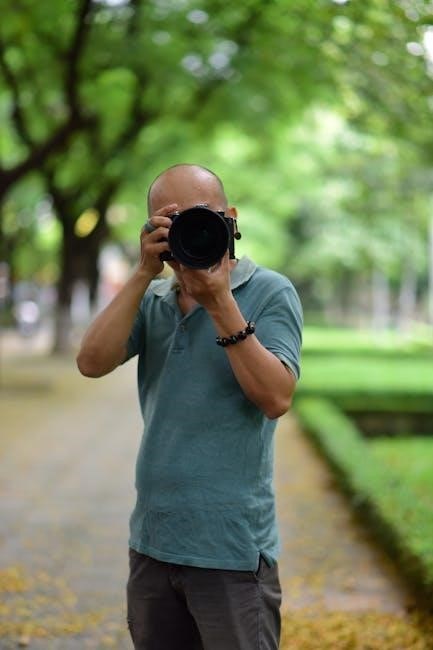Welcome to the Nikon D40X User Guide! This comprehensive guide helps you master the camera’s features, from basic operation to advanced techniques, ensuring you unlock its full potential.
Key Features of the Nikon D40X
The Nikon D40X is a 10.2-megapixel DSLR camera designed for enthusiasts and professionals alike. It features a high-performance CMOS sensor, delivering crisp images with excellent detail and color accuracy. The camera boasts a 2.5-inch LCD screen for easy image review and menu navigation. With 3D Color Matrix Metering II, it ensures precise exposure control. The D40X supports a wide ISO range of 100-1600, reducing noise in low-light conditions. Its 11-point autofocus system provides fast and accurate focusing, while continuous shooting at 3 frames per second captures dynamic action. The camera is compatible with Nikon’s F-mount lenses, offering versatility for various photography needs. These features make the D40X a versatile tool for capturing stunning images in diverse settings.
Target Audience and Camera Overview
The Nikon D40X is tailored for photography enthusiasts and professionals seeking a balance between performance and portability. Its intuitive design makes it accessible to newcomers while offering advanced features for experienced photographers. The camera is ideal for capturing portraits, landscapes, and action shots, thanks to its responsive autofocus and high-speed continuous shooting. With a lightweight and durable construction, the D40X is suitable for both studio and outdoor use. It supports RAW and JPEG formats, providing flexibility in post-processing. Whether you’re refining your skills or expanding your creative horizons, the D40X serves as a reliable companion, offering the tools needed to produce high-quality images across various genres of photography.

Camera Construction and Components
The Nikon D40X features a durable, lightweight body with intuitive controls, including a mode dial, LCD screen, and memory card slot, ensuring easy access to essential functions.
External Controls and Buttons
The Nikon D40X features a user-friendly design with strategically placed external controls and buttons for easy access. The mode dial on top allows quick switching between shooting modes, while the shutter release button is positioned for comfortable finger placement. Other key controls include the aperture/exposure compensation button, AF-area mode selector, and the multi-selector for navigating menus and selecting focus points. The LCD screen on the rear provides essential information, and the memory card slot is conveniently located on the side. These controls are designed to streamline workflow, enabling photographers to focus on capturing moments without distractions. The ergonomic layout ensures intuitive operation, making it easy to adjust settings and explore creative possibilities.
Camera Modes and Shooting Options
The Nikon D40X offers a variety of camera modes and shooting options to suit different photography needs. The mode dial provides quick access to Auto Mode, Program Mode, and Scene Modes like Portrait, Landscape, and Night Portrait. These modes automatically adjust camera settings for optimal results. For more control, the camera features Manual Mode, Aperture Priority, and Shutter Priority, allowing photographers to fine-tune exposure settings. Additional options include Single Shot AF, Continuous AF, and Manual Focus for precise control over focusing. Custom settings can also be saved for quick access, enhancing workflow efficiency. These modes and options empower photographers to capture high-quality images tailored to their creative vision and technical requirements.

Basic Photography Concepts
Mastering aperture, shutter speed, and ISO is essential for controlling light and achieving desired effects. Understanding the exposure triangle helps balance these elements for optimal image quality and creative control.
Aperture, Shutter Speed, and ISO Explained
Aperture refers to the camera’s iris, controlling light entry and depth of field. Lower f-stops (e.g., f/2.8) mean a larger aperture, creating a shallower focus, while higher f-stops (e.g., f/16) result in a deeper focus.
Shutter Speed determines how long the camera’s shutter stays open, measured in seconds or fractions of a second. Faster speeds (e.g., 1/1000th of a second) freeze motion, while slower speeds (e.g., 1 second) create blur.
ISO sets the camera’s sensitivity to light. Lower ISOs (e.g., ISO 100) are ideal for bright conditions, while higher ISOs (e.g., ISO 6400) are used in low light, though they may introduce noise.
Understanding the Exposure Triangle
The Exposure Triangle is the foundation of photography, balancing aperture, shutter speed, and ISO to achieve perfect exposure. Aperture controls light entry and depth of field, with lower f-stops creating a shallower focus. Shutter speed manages motion capture, freezing or blurring subjects. ISO adjusts light sensitivity, with lower values suited for bright conditions and higher values for low light, though risking noise. Balancing these elements ensures optimal image quality, whether freezing fast action or creating artistic blur. Mastering the Exposure Triangle is key to unlocking creative control in photography, allowing photographers to adapt to various lighting conditions and achieve their desired visual effects. This balance is essential for capturing stunning images with the Nikon D40X.

Nikon D40X Specific Features
The Nikon D40X offers advanced features like Live View Mode, enhanced autofocus, and custom settings, providing photographers with precise control and versatility for diverse shooting scenarios.
Live View Mode and Its Benefits
Live View Mode on the Nikon D40X allows photographers to preview shots directly on the camera’s LCD screen, enabling precise focus control and composition. This feature is particularly useful for macro photography, portrait shots, and when using manual focus lenses. It also aids in reviewing images immediately after capture, ensuring adjustments can be made on the spot. The Live View Mode enhances creativity by providing a real-time preview, helping photographers achieve their desired results more efficiently. Additionally, the Nikon Manual Viewer 2 app offers detailed guidance on utilizing this feature, making it accessible for both beginners and advanced users to explore its full potential.
Autofocus System and Metering Modes
The Nikon D40X features a 12-bit TTL phase detection autofocus system with the Multi-CAM 530 sensor module, offering fast and accurate focus acquisition. The AF-assist illuminator enhances low-light focusing capabilities, ensuring sharp images even in challenging conditions. The camera also provides three metering modes: 3D Color Matrix Metering II, Center-Weighted, and Spot Metering. These modes allow photographers to achieve precise exposure control, catering to various lighting scenarios. The 3D Color Matrix Metering II is particularly advanced, considering color and brightness for balanced results. Understanding and utilizing these autofocus and metering options empowers users to capture professional-grade images with ease and precision.
Custom Settings and Preset Options
The Nikon D40X offers a range of customizable settings and preset options to tailor camera behavior to individual preferences. The Custom Settings menu allows adjustments to autofocus tracking, metering modes, and bracketing options. Users can also configure button assignments and dial operations for enhanced workflow. Additionally, the camera supports preset white balance settings, which can be fine-tuned or saved for specific shooting conditions. These customization features enable photographers to streamline their workflow and adapt the camera to their unique shooting styles, ensuring optimal performance in various environments. By exploring these options, users can unlock the full potential of the D40X and achieve consistent, high-quality results in their photography.

Setting Up the Camera
Setting up the Nikon D40X involves initial configuration, such as date, time, and language settings, as well as customizing shooting modes and menu preferences for personalized use.
Initial Setup and Configuration
Begin by attaching the lens and charging the battery; Insert a memory card and power on the camera. Navigate to the menu to set the camera clock, language, and video mode. Use the Nikon Manual Viewer 2 app to download and view the manual offline. Format the memory card in the camera to ensure proper function. Set the file format (JPEG/RAW) and white balance according to your preferences. Adjust autofocus settings if needed, utilizing the AF-assist illuminator for low-light conditions. Review and update firmware via Nikon’s official website for the latest features and improvements. Explore custom settings to personalize your shooting experience, ensuring optimal performance for your photography needs.
Customizing Camera Settings for Personal Use
Customizing the Nikon D40X to suit your photography style enhances your shooting experience. Assign frequently used functions to buttons for quick access. Adjust ISO sensitivity settings to match your preferences for low-light photography. Set up custom white balance presets for consistent color accuracy. Explore and configure autofocus modes, such as AF-C for dynamic subjects or AF-S for stationary ones. Use the built-in flash settings to tailor lighting effects. Save your configurations as custom shooting profiles for easy recall. Experiment with metering modes to achieve desired exposures. Fine-tune settings like exposure compensation and bracketing for precise control. Regularly update firmware to access new features and improvements. By personalizing these settings, you can streamline your workflow and capture images that reflect your creative vision.
Updating Firmware and Software
Keeping your Nikon D40X firmware and software up to date ensures optimal performance and access to the latest features. Regular firmware updates improve autofocus accuracy, add new functionality, and fix any bugs. To update, visit Nikon’s official website and download the latest firmware version compatible with your camera. Use a memory card to transfer the update file to your camera. Follow the on-screen instructions carefully to avoid interruptions, as this could damage the camera. Additionally, update Nikon-specific software like Camera Control Pro or ViewNX for enhanced compatibility. Always use official Nikon sources to avoid malware or corrupted files; After updating, reset the camera to apply changes. This ensures your Nikon D40X operates at its best, delivering improved usability and image quality. Regular updates are crucial for maintaining peak performance and unlocking new capabilities.

Shooting Modes and Techniques

Explore the Nikon D40X’s shooting modes and techniques to enhance your photography. Master Auto, Program, and Manual modes for capturing stunning images with precision and creativity.
Auto Mode, Program Mode, and Scene Modes
The Nikon D40X offers versatile shooting modes to suit every situation. Auto Mode simplifies photography by automatically adjusting settings, ideal for beginners. Program Mode allows slight customization while maintaining ease of use. Scene Modes optimize settings for specific scenarios like portraits, landscapes, or sports, enhancing image quality. These modes enable photographers to focus on composition and creativity, ensuring stunning results in various conditions. Whether you’re capturing candid moments or experimenting with artistic styles, the D40X’s intuitive modes provide the flexibility to achieve professional-grade shots effortlessly.
Manual Mode and Advanced Shooting Techniques
Manual Mode on the Nikon D40X grants full control over aperture, shutter speed, and ISO, allowing photographers to fine-tune settings for precise results. Use the rear dial to adjust shutter speed and the aperture button with the front dial for f-stop control. Advanced techniques like bracketing enable capturing multiple exposures for HDR, while RAW format ensures maximum image detail for post-processing. Leveraging the camera’s metering modes and focus lock enhances creative control. Experiment with white balance adjustments to achieve desired color tones. For advanced shooters, manual focus and custom settings offer unparalleled flexibility. Mastering these techniques unlocks the D40X’s full potential, enabling photographers to express their vision with precision and artistry.
Image Quality and Storage

The Nikon D40X ensures exceptional image quality through precise settings and storage solutions. It supports JPEG and RAW formats, enabling detailed post-processing. Use high-capacity memory cards for optimal storage and organization.
Understanding File Formats (JPEG, RAW)
The Nikon D40X offers two primary file formats: JPEG and RAW. JPEG compresses images for smaller file sizes, making them ideal for sharing and storage. It’s processed in-camera, applying sharpening, contrast, and color balance. RAW files, however, store unprocessed data, retaining maximum detail for advanced editing. They are larger but provide greater flexibility in post-processing. The camera allows simultaneous capture of both formats, ensuring versatility for different workflows. Understanding these formats is crucial for optimizing image quality and workflow efficiency. Use the menu system to select your preferred format based on your creative needs and storage capacity. This feature empowers photographers to balance convenience and control, catering to both professionals and enthusiasts.
Memory Card Management and Storage Options
Effective memory card management is essential for maximizing the Nikon D40X’s performance. Use high-speed SD or SDHC cards to ensure smooth image capture and transfer. Regularly format your cards in the camera to maintain optimal performance and prevent data corruption. Always store cards in protective cases to avoid damage. Consider using multiple cards to organize your shots or separate RAW and JPEG files. For storage, transfer images to external drives or cloud services to free up space and ensure backups. Proper card maintenance, such as avoiding excessive reformatting, helps preserve data integrity. By managing your memory cards efficiently, you can enhance your workflow and ensure your photos are safe and accessible. This practice is vital for both professionals and enthusiasts aiming to organize their photography effectively.

Focusing and Flash
The Nikon D40X features advanced autofocus modes and a built-in flash for versatile lighting control. These tools enable precise focus and optimal illumination for capturing sharp, well-lit images.
Autofocus Modes and Focus Lock
The Nikon D40X offers advanced autofocus modes, including Single-Servo AF and Continuous-Servo AF, ensuring precise focus control. Focus Lock allows you to lock focus on a subject, enabling sharp images even when the composition changes. The Multi-CAM 530 autofocus sensor provides fast and accurate focusing across various lighting conditions. By understanding and utilizing these modes effectively, photographers can achieve professional-level results with ease. The camera also supports AF-assist illuminator for low-light situations, enhancing focus acquisition. These features make the D40X versatile for capturing dynamic and stationary subjects alike.
Using External Flash and Built-in Flash
The Nikon D40X offers versatile flash options to enhance your photography. The built-in flash provides convenient lighting for low-light situations and can be adjusted to suit your needs. For more advanced lighting control, the camera supports external flash units, enabling creative possibilities like off-camera illumination. The i-TTL (Intelligent Through-The-Lens) flash metering system ensures accurate exposure by measuring light through the lens. Features like rear-curtain sync allow for dynamic effects, such as blurring moving subjects while keeping the flash sharp. External flashes can be synchronized wirelessly or via cords, expanding your creative freedom. Properly using these flash options can significantly improve image quality and open up new possibilities for capturing stunning photos in various lighting conditions.
Troubleshooting Common Issues
This section helps resolve common challenges with the Nikon D40X, such as autofocus errors and exposure problems, ensuring optimal performance and enhancing your photography experience.
Resolving Autofocus Errors
Autofocus errors can hinder your photography experience. Ensure the lens is clean and free from debris, as dirt can interfere with AF performance. Check the AF mode settings in the menu to confirm it matches your shooting scenario. If issues persist, reset the AF system by turning the camera off and on. Use the AF assist light in low-light conditions to improve focus accuracy. Additionally, verify that the camera firmware is up-to-date, as updates often resolve AF-related bugs. For persistent problems, refer to the Nikon D40X manual or contact support for professional assistance. Regular maintenance and proper handling can prevent autofocus malfunctions, ensuring sharp and precise images every time.
Fixing Exposure and Image Quality Problems
Exposure and image quality issues can be addressed through adjustments in camera settings. Check the exposure compensation and ensure it’s set to neutral or adjust it based on lighting conditions. Use the histogram to evaluate exposure accuracy and make necessary corrections. For overexposed or underexposed images, bracketing shots can help capture a range of exposures for later merging. Noise reduction settings can mitigate grain in low-light photos. Sharpening adjustments in the menu enhance image clarity. If using RAW format, post-processing allows fine-tuning exposure and noise reduction. Ensure the lens is clean and free from smudges to avoid artifacts. Referencing the Nikon D40X manual provides detailed guidance on optimizing these settings for superior image quality. Regular software updates also improve camera performance and image processing capabilities, ensuring the best results. Proper handling and care of the camera further enhance image quality, making every shot a masterpiece.

Maintenance and Care
Regular cleaning of the lens and sensor prevents dust and smudges. Use a soft cloth and avoid harsh chemicals. Store the camera in a dry, cool place to prevent moisture damage. For extended storage, remove the battery and memory card. Use a UV filter to protect the lens from scratches. Avoid extreme temperatures and humidity, which can harm internal components. Follow the Nikon D40X manual’s guidelines for optimal care and longevity of your camera. Proper maintenance ensures consistent performance and image quality over time.
Cleaning and Maintaining the Camera
Regular cleaning and maintenance are essential to ensure the Nikon D40X functions optimally and maintains image quality. Use a soft, dry microfiber cloth to wipe the camera body and lens, avoiding harsh chemicals. For the sensor, use a blower or cleaning brush to remove dust particles. Never touch the sensor surface directly. Store the camera in a cool, dry place to prevent moisture buildup. Remove the battery and memory card during long-term storage to avoid corrosion. Use a UV filter to protect the lens from scratches and dirt. Refer to the Nikon D40X manual for detailed cleaning instructions and recommendations. Proper care extends the lifespan of your camera and ensures consistent performance.
Extending Camera Lifespan and Performance
To extend the lifespan and performance of your Nikon D40X, regular maintenance and careful handling are crucial. Always store the camera in a protective case or bag to prevent scratches and damage. Avoid exposing the camera to extreme temperatures or humidity, as this can harm internal components. Clean the camera body and lenses regularly using a soft cloth and avoid touching the sensor. Update the camera firmware periodically to ensure optimal functionality. Use high-quality memory cards and avoid removing them during write operations to prevent data corruption. Replace the battery when it shows signs of degradation, and keep the camera’s software up to date. Proper care ensures your Nikon D40X remains reliable and continues to deliver high-quality images over time.
